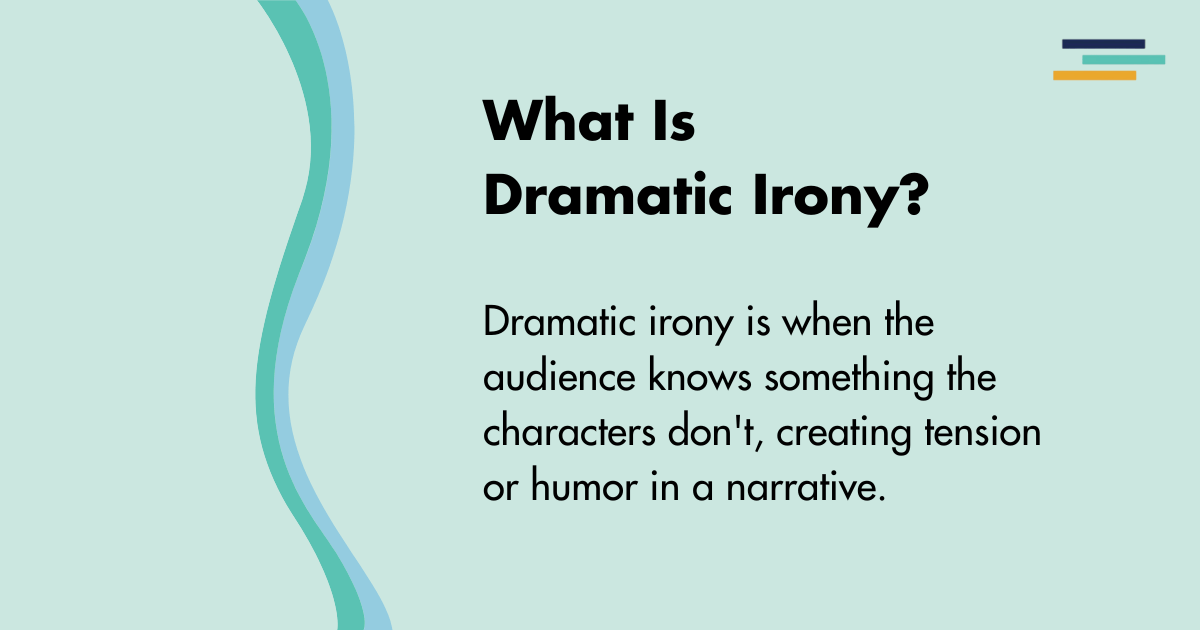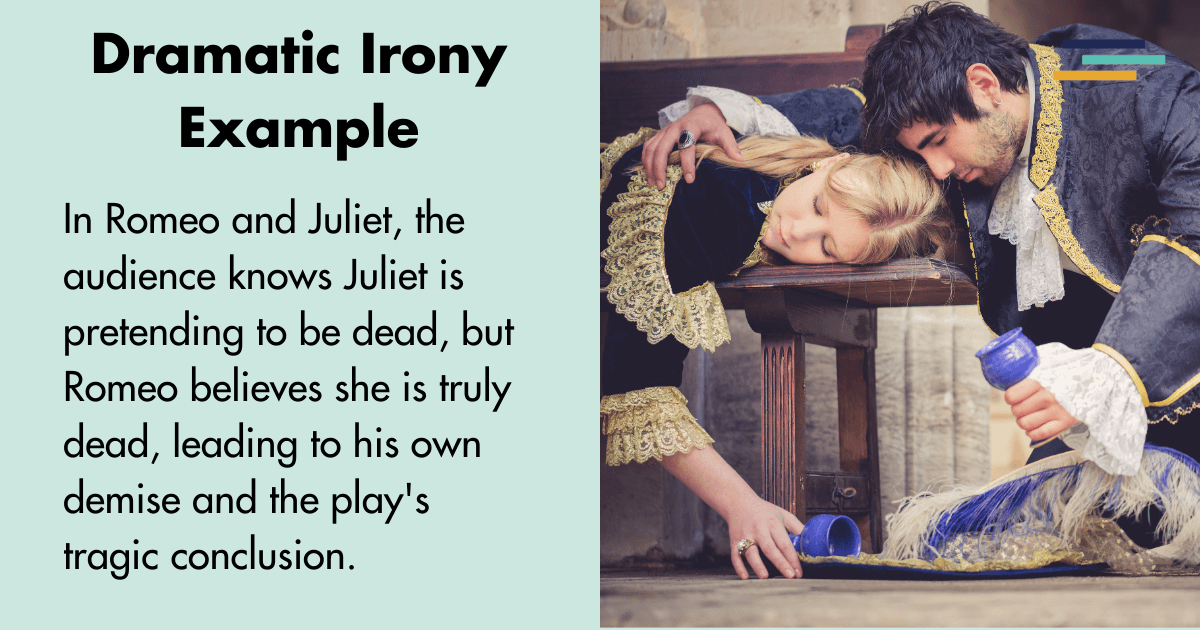
Dramatic irony is not rain on your wedding day. After all, some people see the beauty in rain, and many people have indoor weddings and receptions that will be unaffected by the rain. Unless you are made of a pillar of salt, like Lot’s wife in the Bible, then there might be some situational irony.
Or you could sarcastically say, “I just love the rain.” And we’ll have verbal irony.
Dramatic irony (which gets its name from Greek drama) originated as far back as the Iliad and the Odyssey. Towards the end of the epic poem, Odysseus disguises himself as one of Penelope’s suitors. He has changed so much that his own wife doesn’t recognize him, but the audience knows who he is. They wait with bated breath to see if the couple will be reunited and if Odysseus’s journey is finally over!
Dramatic irony may be an old tool, but it isn’t out of date! And it may seem like some complicated English thing, but it really isn’t. Especially not when you have the Fictionary StoryTeller software to help you keep track! Keep reading to discover what dramatic irony is, how it compares to other forms of irony, some examples in more modern works, and how you can use it in your own writing.
What Is Dramatic Irony?
Who loves a secret? Your reader!
Dramatic irony is a form of irony (obvious, I know) that is sometimes referred to as a knowledge gap.
The audience of your novel, movie script, television show, play, etc. knows things that the character does not know. This changes the meaning of their words and actions to the audience or even another character within the story.
Dramatic irony can do four things:
- Increase tension and conflict because the audience knows ahead of time some consequences of a character’s actions
- Enhance the emotional impact of the scene because of the knowledge gap between what the audience knows and what the character knows
- Strengthen the internal point of view goal as the audience comes to comprehend the character’s personality, understanding, motivations, and (most of all) flaws
- Intensify the reader experience as the audience feels powerful and reader knowledge is gained
Dramatic Irony Meaning
First, let’s iron out some wrinkles.
Ah, irony, irony, irony. How does dramatic irony differ from other types of irony, such as verbal irony and situational irony?
Dramatic irony is a part of the structure of the story, and it creates tension or suspense because the audience knows more than a character does.
One character is an undercover police officer, and another character is blackmailing the protagonist into doing something illegal. The audience knows the protagonist isn’t a criminal, and they also know the protagonist is now caught between a rock and a hard place.
Verbal irony is within the dialogue or thoughts of the characters, and it is when they say or think something different from how they feel. This includes sarcasm and double entendres and is caused by the character themselves. “What a good boy,” your character says while staring at a rabid, snarling wolf.
Situational irony lies within the very situation itself. When something unexpected happens, like how Chinese alchemists tried to create a chemical that would cause immortality and accidentally created gunpowder, that’s situational irony. Or a doctor who is sick. Or a mechanic with a car that won’t run. You get the idea.

Dramatic Irony Examples
Examples of Dramatic Irony in Literature
Dramatic irony has historically been used in tragedy. Romeo and Juliet has one of the most well-known tragic endings where the audience knows the characters are not dead, but they believe differently.
However, one of my favorite short stories is “The Gift of the Magi” by O. Henry, which has more of a wholesome tragic ending.
The couple is very poor but love each other so much that they wish to get the best Christmas presents for one another. The wife sells her hair, her most prized possession, in order to afford a watch chain for her husband. Meanwhile, the husband sells his watch, his most prized possession, in order to afford a comb for his wife.
The audience knows what is happening, creating tension and suspense. Then the dramatic irony is revealed to the characters when they exchange gifts. The gifts themselves are useless, but the love and meaning behind the gifts are priceless to the couple.
In A Good Girl’s Guide to Murder, Pippa and the reader are the only ones in her town who know that she is using her senior project as an excuse to investigate a murder and prove her friend innocent. This creates a lot of lovely dramatic irony where the audience is in on the secret with the protagonist, and everyone else is unaware. During the course of the book, Pippa keeps a lot of other secrets with the audience, thinking she is the only one who knows.
Dramatic irony can also be used to emphasize a moral like in the fairytale Snow White. When the girl is offered an apple by a seemingly kind old woman, the audience knows that the woman is just the evil queen in disguise and the delicious-looking apple is poisoned. Morals taken from this story are to not trust strangers or appearances, and the dramatic irony enhances the reader’s learning of this lesson.
In “Count the Ways,” the second short story in the first Fazbear Frights series, the story alternates between present and past, starting with Millie trapped within an animatronic and being told that she gets to choose the way she dies. This means when the story goes into a flashback of how everything started, the reader knows she is going to climb into the bear for some reason and the bulk of the story, which occurs in the past, carries dramatic irony.
Examples of Dramatic Irony in TV
Monk is a television show from the 90s (which recently saw a revival in a film) about a detective with obsessive-compulsive disorder. There is situational irony because he is a detective who cannot solve his own wife’s murder. And while the show also teaches understanding of someone with mental disorders, every episode is packed with dramatic irony.
The audience knows at the beginning of the episode that two things will happen. One, Monk will solve the murder that no one else can because of the unique way his brain works. And two, something will go badly wrong because of his OCD (the way his brain works). Here, dramatic irony is used both for humor and tragedy.
In Stranger Things, the group of protagonists and the audience are the only ones who know what is going on in “the upside down.” Whenever the characters split up, the audience knows what is going on with each group, but the others are in the dark. This dramatic irony creates lots of tension.
Example of Dramatic Irony in Film
In horror, dramatic irony is often used to create the suspense of who will die? The audience often knows that the monster is lurking, but the characters do not.
For example, in the Creature from the Black Lagoon, the characters are in the water, exploring the beauty of the Amazon and searching for paleontological clues, while the audience can see the creature swimming below, watching them, and even reaching out with near misses!
So while you’re yelling at the person going down into the basement where the killer lurks, think about whether a little darkness would keep you out of your own basement. You are a victim of dramatic irony.
Dramatic irony can also be used in comedy as in Toy Story. Buzz LightYear believes himself to be a living breathing space ranger, while Woody, Andy’s toys, and the audience know better.
Who can’t forget the scenes where Woody presses Buzz’s button to retract his helmet and Buzz starts gasping? Or “To infinity and beyond” when Buzz jumps off the bed and ends up flung into the air by riding on a car on the Hotwheel’s track? “That’s not flying, that’s falling with style,” says Woody.
Or in the movie Oscar, when there are three identical looking bags that keep getting mixed up, one with jewels, one with money, and one with a woman’s underclothes. The audience watches as one character changes the bag out and another thinks it is the same bag and gives it to someone else. It adds layers of confusion to the plot.

How to Write Dramatic Irony
Creating dramatic irony in your work is easier than you think. Many writers often do this naturally. The 38 Fictionary Story Element of reader knowledge gained is the best place to look for dramatic irony.
When writing first person, sharing a secret with the narrator or protagonist is the easiest way to us dramatic irony. But an easier way to create a knowledge gap between characters and the audience is by using different points of view.
In a romance, dramatic irony adds to the tension as the reader knows that he likes her and she likes him, but the two characters are fighting against it or being misled by their own flaws. The reader loves the tension of knowing the two will eventually get together but not the when or how.
Or maybe in a sci-fi, one person understands the technology required, while another can determine the safety level of the botany of a new planet. This is how an exploratory group of first settlers is determined. Each person has a piece of information the others don’t, but the reader has them all and can start to look for patterns and put things together before the characters do.
In Fictionary’s software, the elements of POV, POV goal, and POV goal internal can help you create the dramatic irony you are looking for.
In a mystery, horror, or fantasy, showing the antagonist’s POV in a few scenes will increase the conflict and tension. While the protagonist will be blissfully unaware, the reader will know what terrible things the bad guy has in store for your characters. Like in our Snow White example, the audience will be able to see past disguises and deceptions because they have seen the truth.
Also, as in our example of “Snow White,” you can use dramatic irony to emphasize the themes of your story or by foreshadowing future events. This can be found in dialogue, but it is often found in the setting elements of your world.
The elements of location, objects, sights, smells, sounds, emotional impact, and weather often lend themselves to making the reader aware that something is different than the characters think.
The complexity of a character driven novel, like YA or women’s fiction, can cause dramatic irony as the protagonist exposes their weaknesses and flaws. The character can be unaware of their true heritage or have lost their memory and be slowly regaining it.
The plot elements of revelation, backstory, flashbacks, and the character element of story goal tracker can help the reader sympathize with the character when the dramatic irony is revealed.
Dramatic Irony Conclusion
Shhhh. Keep this secret between you and me to create some terrific dramatic irony. Then, using the Fictionary StoryTelling software and a Fictionary StoryCoach edit, you can craft a story readers will not be able to put down!
With dramatic irony running through your plot and strengthening your 38 Fictionary Story Elements, the story that you dream of can become a reality!
If you want to learn more about dramatic irony, read the lovely craft book The Story Book by David Baboulene. There is a review done by yours truly in the craft book corner of the community.


